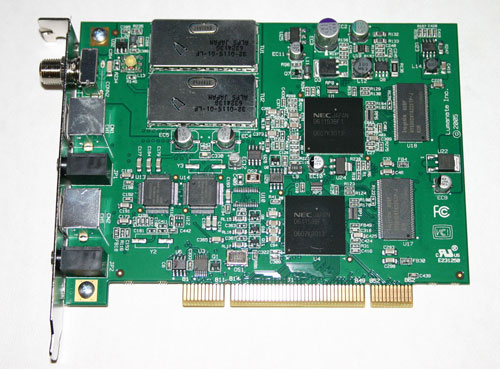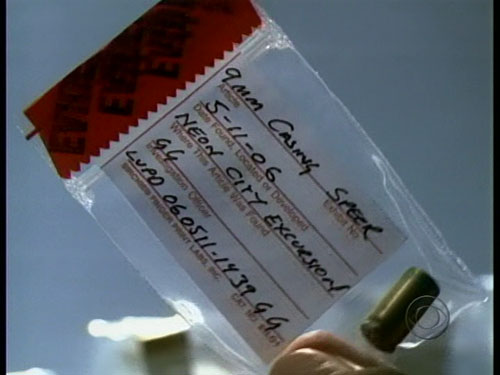Dell XPS 410: Core 2 Duo for the Masses
by Jarred Walton on September 18, 2006 12:20 PM EST- Posted in
- Systems
Multimedia Capabilities
One final item to talk about is the included TV tuner. The card is manufactured by Lumanate, Inc., and it includes a couple of Micronas chips as well as two NEC chips on the PCB. Windows Device Manager lists the dual TV tuner as Angel II MPEG. The card is naturally fully compatible with Windows Media Center Edition 2005. First, here's a shot of the card itself.
We did not try to test the TV tuner with other HTPC applications, but we did conduct some basic quality testing using the standard Windows MCE interface. Once MCE was set up for our location, watching and recording channels was extremely easy. In terms of quality, the picture looks good and subjectively compares to most other dual analog TV tuners. Without extensive testing time with additional cards, we can't say for certain whether it is equal to, better than, or not as good as other TV tuners we have reviewed. We would suspect it has a slightly lower quality image than the top analog tuners, but even the best analog signal pales in comparison to your standard HDTV signals. We captured a few sample videos to demonstrate the quality, seen below.
Note that deinterlacing is handled in part by the software during playback, so the output of Windows Media Center looks slightly different than what you might see in other media players. We chose to capture the unprocessed videos at their native resolution using Windows Media Player 10. You can spot some interlacing artifacts because of our capture methodology.
If you are looking for the absolute best quality analog tuner on the market, you'll probably want to do more research. Of course, if you are purchasing the XPS 410, you don't really get a choice about what TV tuner you want included. You can either get the dual-TV tuner or the single channel tuner, but both offer similar quality. In terms of out-of-the-box experience, the TV tuner left little to be desired. It works, the image quality looks about as good as most other analog TV tuners we have tested, and the Windows MCE interface is very easy to use.
One final item to talk about is the included TV tuner. The card is manufactured by Lumanate, Inc., and it includes a couple of Micronas chips as well as two NEC chips on the PCB. Windows Device Manager lists the dual TV tuner as Angel II MPEG. The card is naturally fully compatible with Windows Media Center Edition 2005. First, here's a shot of the card itself.
 |
| Click to enlarge |
We did not try to test the TV tuner with other HTPC applications, but we did conduct some basic quality testing using the standard Windows MCE interface. Once MCE was set up for our location, watching and recording channels was extremely easy. In terms of quality, the picture looks good and subjectively compares to most other dual analog TV tuners. Without extensive testing time with additional cards, we can't say for certain whether it is equal to, better than, or not as good as other TV tuners we have reviewed. We would suspect it has a slightly lower quality image than the top analog tuners, but even the best analog signal pales in comparison to your standard HDTV signals. We captured a few sample videos to demonstrate the quality, seen below.
 |
 |
 |
| Click to enlarge |
Note that deinterlacing is handled in part by the software during playback, so the output of Windows Media Center looks slightly different than what you might see in other media players. We chose to capture the unprocessed videos at their native resolution using Windows Media Player 10. You can spot some interlacing artifacts because of our capture methodology.
If you are looking for the absolute best quality analog tuner on the market, you'll probably want to do more research. Of course, if you are purchasing the XPS 410, you don't really get a choice about what TV tuner you want included. You can either get the dual-TV tuner or the single channel tuner, but both offer similar quality. In terms of out-of-the-box experience, the TV tuner left little to be desired. It works, the image quality looks about as good as most other analog TV tuners we have tested, and the Windows MCE interface is very easy to use.










50 Comments
View All Comments
mino - Monday, September 18, 2006 - link
Otherwise this machine is pretty solid, no question about it, ideal for making your average clueless kid an game addict.One thing not reasonable is the lack of RS232, LPT, PS/2 and FW, that makes it unusable as far as I'm concerned.
Just wonder, will the ATX channel case builders ever actually LEARN how to make a proper AND cheapo case???
It is possible and pretty easy to do at the same time, yet they are like afraid to make a killer product...
Bluestealth - Tuesday, September 19, 2006 - link
Really...
Most mouses nowadays are usb
Keyboards also come in usb(although there are still a lot of PS/2 keyboards),
RS232... USB Serial Port?(I realize the network guys use these, but they are obsolete for the general person),
FW... I haven't run into something that "required" this for a while,
LPT... soon there won't be many LPT printers left surviving, and again there are USB adapters.
I wish my new motherboard didn't have RS232/LPT/PS/2, they just waste space.
It did however come with lots of USB and 2 FW ports, which is nice.
mino - Tuesday, September 19, 2006 - link
PS/2 usually just works, USB works, OS loads up and USB mouse turns off.I had amny times such a situation.That was just a single example..
I am OK with an no-legacy approach as along as it is meaningfull.
However to make legacy-free boards by removing all legacy stuff and not use the place for any other usage (i.e another 4-6 USB ports) is stupid.
Also 6 USB ports as a complete I/O ? that's a joke!
keyboard, mouse, printer, scanner, monitor, RS232 adapter and you have not a single port left!
6 USB is nice if you have all that legacy - the big reason we use PS/2 KB and mouses is it frees up 2 USB ports.
As for RS232, there is s huge amount of various equipment _produced_ for RS232! Why? because it makes no sense to go (pretty complicated vs. RS232) USB for simple data-reporting tasks.
Bluestealth - Tuesday, September 19, 2006 - link
Some companies use a USB to serial chip (or emulation) to allow them to easily upgrade their products, and for something that was designed with USB in mind, which is ever increasing, it will cease to be a problem.I currently have 1 USB Joystick, 1 Keyboard/Mouse Transceiver, 1 RF Remote. That is only 3 ports for me, I have 4 Rear USB ports, can add 4 more, a 4 port hub (plug stuff in on my desk easier), and have 2 front USB ports. For a majority of people 6 is NO PROBLEM, there are USB hubs for a reason though.
These computers are not designed for everyone, they are designed for most people, most people nowadays will not use the LPT/serial ports, while a lot still may still use PS/2 ports dell "provided" a USB keyboard and mouse. Most people have a mouse, keyboard, printer, and "maybe" something else such as a scanner.
It would be great if there were 8 USB ports on the back but I am assuming the last 2 went to that card reader. Intel decided on 10 USB ports, dell would have to add in card to support more, or add an additional chip to the board.
Monitor... did you not see the 2 DVI ports? (I don't know how you even justify listing this), RS232 is not required for most people.
Ok I did go on a rant, but this just screams of stupidly, USB is an expandable bus; it doesn’t have a fixed number of ports, only devices which is 127(?) per controller.
Sure they are saving quite a bit of money on an I/O chip from winbond, but in the end it doesn’t affect many people, so why not?
JarredWalton - Tuesday, September 19, 2006 - link
Two USB on the front, six on back, two more to the flash reader I think. Keyboard+mouse takes one port (the keyboard has two extra ports on it). You've got printer, scanner, headphones, network, and maybe one or two other things that can go USB, but that still leaves one extra port for most people. An LPT/Serial card is an option if you want that (it will use a PCI slot). Most people don't need it, though. If they had put firewire in the extra rear space, that would have allowed the use of a PCI LPT/COM and still have the sound card and TV Tuner. Not sure about PhysX, though... need a PCI-E version I guess.mino - Monday, September 18, 2006 - link
"even on customs" => "even in the case of a custom setup"kmmatney - Monday, September 18, 2006 - link
Dells Suck!Just kidding. When my Mom needed a new computer I had her buy a Dell. Its been trouble-free for several years.
Jetster - Monday, September 18, 2006 - link
i'm really impressed with the case design,especially the internal layout, excellent airflow. easily better than the most standared atx case you can buy on the market now. and AT's statement is so true: "It's almost a shame that most people that purchase an XPS 410 are unlikely to appreciate the ease with which the system can be upgraded."BTW did Dell use the new video card design with the chipset on the other side? casue the hsf is facing upward, which is better imo
Homerboy - Monday, September 18, 2006 - link
yeap. They are designed well, implemented even better and can't be beat bang for the buck. Sure higher-end and performance PCs will never be an pre-builts bread and butter, but they do it perfectly fine for the masses who don't know how to do it themsleves.And as far as their run-of-the-mill "workstations" and home PC are concerned. You simply can_not_beat a big-name manufacture on price and support.
(*please note I build all my own PCs, but family, friends, and workplace all get pre-builts... Dell's actually).
JarredWalton - Monday, September 18, 2006 - link
BTX motherboards have the slots flipped, so the case opens on the right instead of the left. That makes the GPU HSF face upward, as you can see. I didn't go into extreme detail on the BTX format, as I figure the images illustrate it well enough. :)